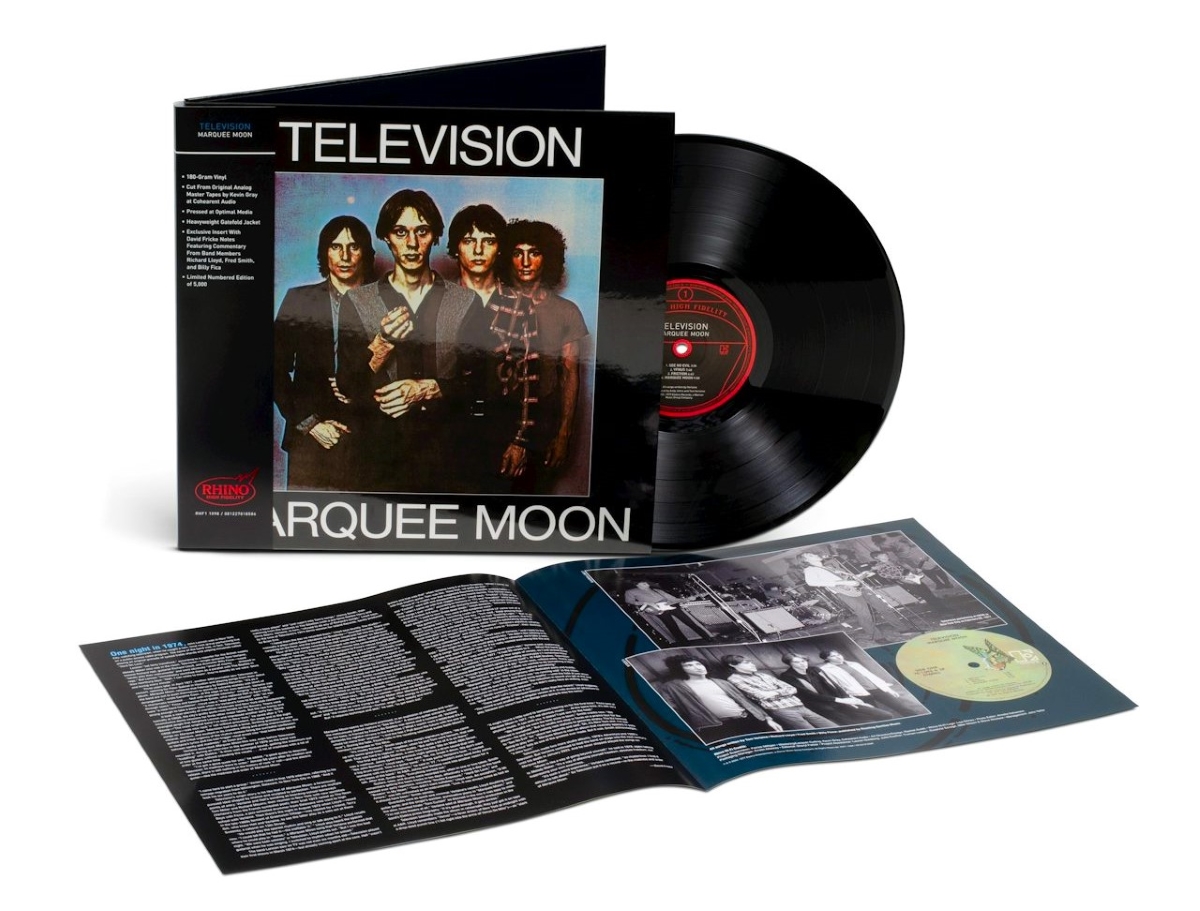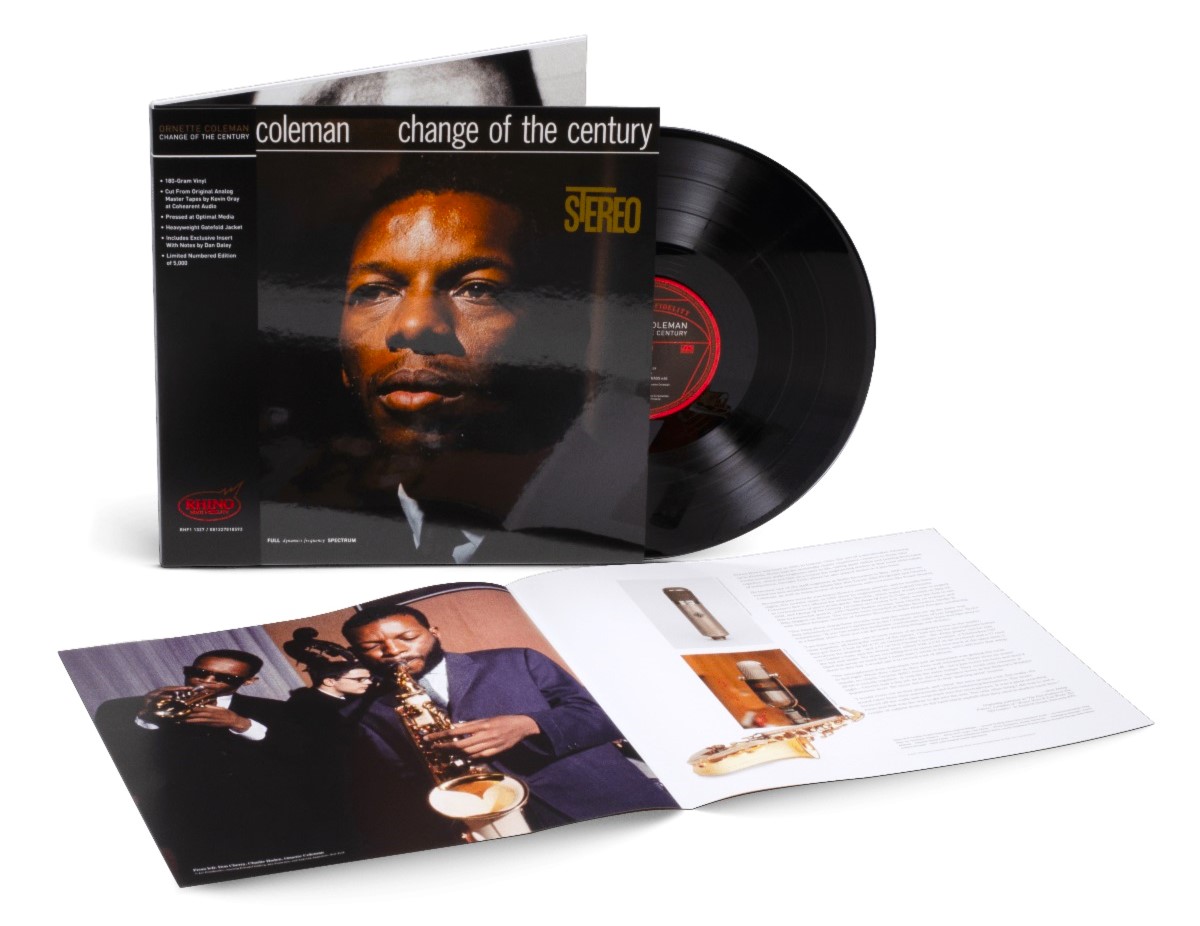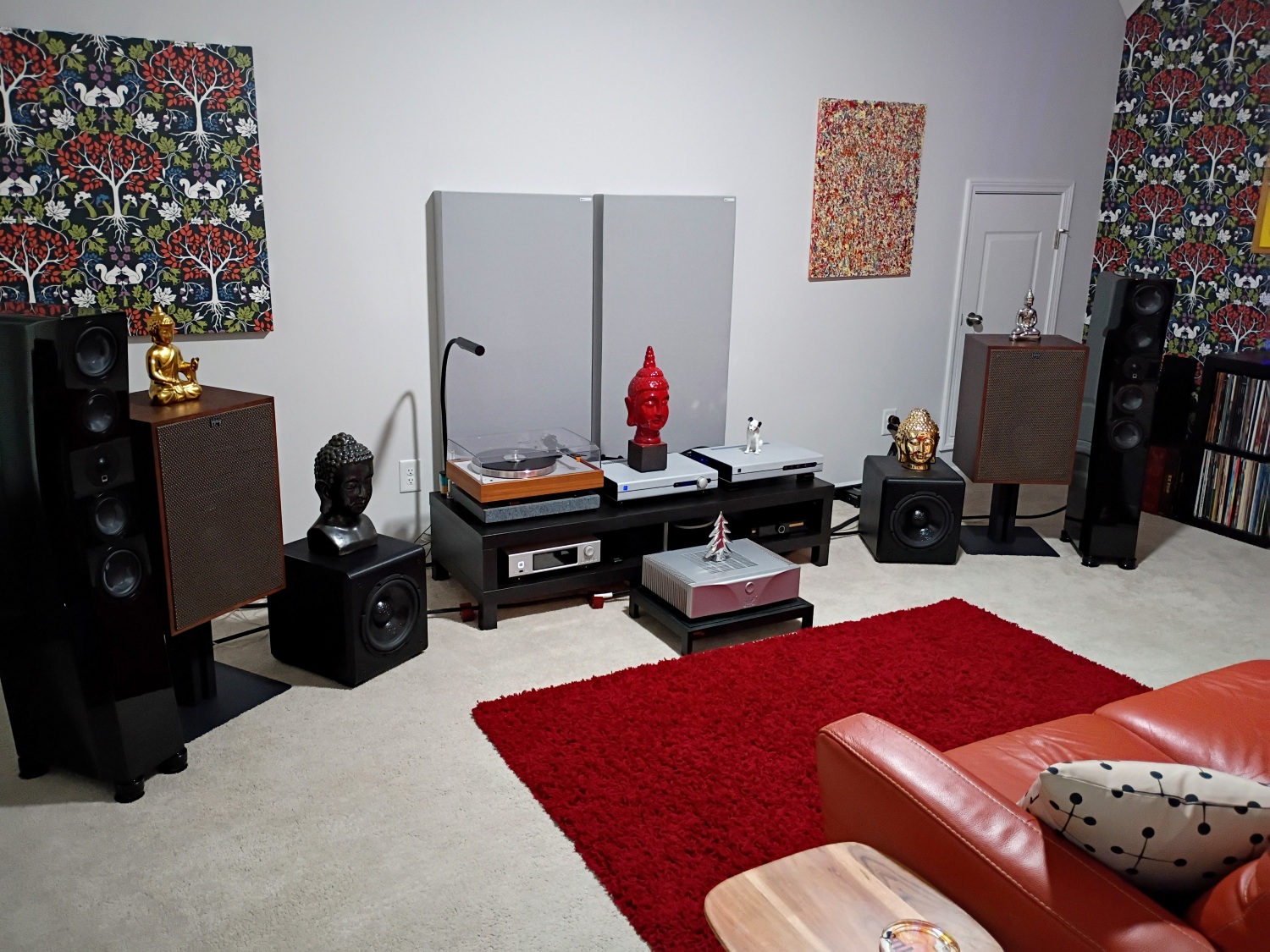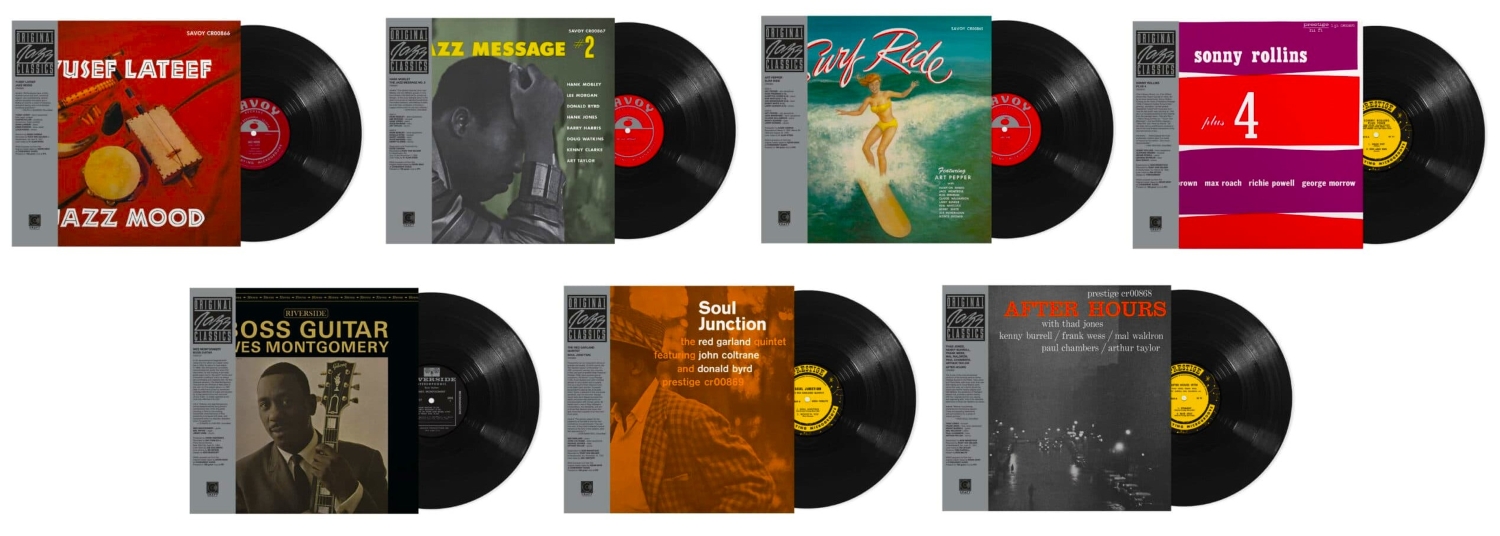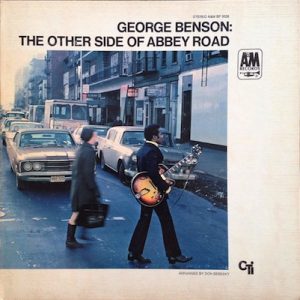The Rhino High Fidelity Premium Vinyl Series continues with the release of two new titles, and as with the previous group of offerings, the selections are eclectic. The one constant is that Rhino has again chosen both rock and jazz titles, featuring Marquee Moon (1977, Elektra Records) from art-punk darlings Television and avant-garde saxophonist Ornette Coleman's Change of the Century (1960, Atlantic Records). These exclusive 180 gram LPs are strictly limited to 5000 numbered copies, are only available from rhino.com, and can be ordered HERE.
Rhino builds on their legacy of sonic goodness with these latest entries in the High Fidelity Premium Series. Both reissues arrived in heavy, tip-on, Stoughton-style jackets that are very faithful to the originals. Each album package is beautifully realized; the album jackets are finished with high gloss coatings that highlight the crisp album artwork that's been sourced from the Warner Brothers archives. The LPs include a stylized OBI strip that enhances their appearance and collectibility. And a newly-designed but classic-looking LP label has been created for the Rhino High Fidelity imprint, which enhances the impression of exclusivity for the series. These LPs are truly among the crème de la crème of current high-end reissues.
Lacquers for both releases were cut from the original analog tapes by Kevin Gray at Cohearent Audio, and the 180 gram LPs were pressed at Optimal in Germany. The surfaces of the LPs were flawless and exceptionally glossy, and arrived inserted into rice paper lined, black paper inner sleeves. It's a perfectionist touch that LPs of this pedigree demand, and audiophiles everywhere will really appreciate the reduction of static and protection from scratching and accumulation of paper dust. Each album includes a beautiful fold-out insert with recording notes and informative essays from artists and session personnel. This series excites me on just about every level in terms of production, packaging, and the very high quality of the transfers.
Television, Marquee Moon. 180 Gram LP, $39.98 MSRP
Television was formed in 1973 in New York City, but its roots can be traced to the friendship formed by Tom Verlaine and Richard Hell while they were students at the exclusive Sanford School in Delaware. They individually left the school, with each heading for New York with the intention of becoming poets, eventually reconnecting a couple of years later. Their participation in various bands eventually gelled in the form of Television, which featured Verlaine on lead vocals and guitar, Hell on vocals and bass, Richard Lloyd on guitar, and Billy Ficca on drums. Although punk music was in full force, and Television had secured a residency at Hilly Kristal's legendary club CBGB, Verlaine was beginning to become more focused on the quality of the band's musicianship. Richard Hell's approach was the complete opposite, and his erratic behavior led to a quick exit from the band; he was then replaced by Fred Smith on bass.
The band's debut album, Marquee Moon, was recorded at NYCs A&R Studios in mid-1976 with Andy Johns as the engineer, and was released in early 1977. The album was immediately hailed as a landmark record and a masterpiece, and Television's near-abandonment of power chords for a more melodic, jazz-rock inspired style was seen as cutting edge on the rapidly evolving music scene. Marquee Moon is frequently cited as one of the greatest influences on the alternative rock, new wave, post-punk, and indie-rock genres that were simultaneously metamorphosing. Most of the material was written just prior to entering the studio, and many of the songs were recorded as single takes with very little post-processing or compression added afterwards. The classic title track, "Marquee Moon," was one of the songs recorded in a single take; drummer Billy Ficca thought the take was a rehearsal. Andy Johns had mixed Verlaine's guitar on the left channel, with Robert Lloyd's guitar on the right, and after hearing the recording, Johns asked if perhaps they should do another take. Tom Verlaine told him to forget about it, and the classic tune that defined a musical movement was born in a single take; the intricate guitar interplay between Verlaine and Lloyd is simply sublime.
Ornette Coleman, Change of the Century. 180 Gram LP, $39.98 MSRP
Saxophonist Randolph Denard Ornette Coleman was the founder of the jazz genre that came to be known as "free jazz," a style that would soon transmogrify along with the avant-garde wing of jazz. Much of his work abandoned many of the stylistic elements of the bebop idiom of jazz that was so popular at the time, including harmonic composition, tonality, and chord changes. Ornette Coleman's style emphasized a more experimental approach to improvisation than typical jazz of the time; whereas he's now regarded as an innovator and a genius, his work was initially met with skepticism. Change of the Century was Coleman's fourth studio album, and arrived a year before his 1961 album Free Jazz set the jazz world on its ear. The album finds Coleman at a point where he hadn't yet completely abandoned harmonic structure, but it definitely was a preview of what was about to come. Change of the Century was recorded over two days in October, 1959 and was released in mid-1960.
Ornette Coleman's working quartet for the past several years featured himself on alto sax, Don Cherry on trumpet, upstart young bassist Charlie Haden, and drummer Billy Higgins. The absence of a piano as part of his music's foundation signaled his abandonment of traditional chordal structures, and Change of the Century builds on the momentum that had started a year earlier on The Shape of Jazz to Come. Despite the universal acclaim Coleman received for The Shape of Jazz to Come, the quartet more completely gelled on Change of the Century. Ornette Coleman and Don Cherry solo furiously throughout, a very young Charlie Haden shows glimpses of the genius he'd display in spades in the coming years, and Billy Higgins' rock-solid drumming anchors the recording. Ornette Coleman wrote the liner notes for the album's original release, and in it he states that there's no wrong or right way to play jazz, and he even compares his music to one of Jackson Pollock's paintings. And that totally sums up Change of the Century: compared to the status quo of the day, it's radical, but still completely beautiful!
Rhino Continues to Raise the Bar with the High Fidelity Series
Click on my name in the header to see the selection of equipment in my dual systems; I used my mostly tubed, all analog setup to evaluate these classic rock and jazz LPs. The turntable for this session was the ProJect Classic EVO that's fitted with an Ortofon Quintet Bronze moving coil cartridge. My all-analog setup has also recently changed to include the PS Audio Stellar phono preamplifier, which offers dual inputs to allow for the connection of two turntables. Besides the new ease of effortless playback of both stereo and mono LPs, the PS Audio pre also has provided a significant improvement in the overall sound quality of my analog playback. Both LPs from Optimal were perfectly flat and the surfaces were pristine; the Ortofon cartridge tracked each LP with no clicks or appreciable groove noise. The sound quality was exceptional, and as with the previous reissue from the Rhino High Fidelity series, the LP pressings from Optimal were among the quietest I've recently had the pleasure to hear. Listening to these albums through tubes and classic acoustic-suspension loudspeakers gave my evaluation an air of vintage authenticity.
A great deal of conjecture has surrounded the recent remastering of classic albums, and whether the resulting sound of the new reissues are in fact true to the original intent of the engineers and producers of yore. A lot has been said specifically about the sound of Rhino High Fidelity's Marquee Moon reissue, which has a significantly smoother and more balanced midrange and top end when compared to the original. And whether or not the harshness of the original was the artist's and production team's intent—I saw a prominent review of this reissue where the writer proclaimed that the late Tom Verlaine would have despised this gentrified version of Television's undeniable masterpiece. I couldn't disagree more; my own original pressing of Marquee Moon is nearly unlistenable, with a level of harshness and stridency that induces listener fatigue in very short order. With Rhino's new remaster, I feel like I'm hearing this classic for the very first time as it was intended to be heard!
I was also greatly impressed with the sound quality of Ornette Coleman's Change of the Century. Much has been written about the production techniques employed on many Atlantic Records jazz titles from the late Fifties and into the early Sixties, which tended to be very hard-left/hard-right, with very little information typically in the middle of the stereo soundstage. Leaving one to generally greatly prefer mono Atlantic pressings over the stereo versions, when available. Perfect examples come from John Coltrane's catalog of Atlantic label recordings—which are undeniable classics from a performance standpoint—but leave a lot to be desired in terms of the stereo spread and production values. Change of the Century was engineered by Bones Howe; I'm familiar with his work on records from Tom Waits, which tended to be very natural-sounding recordings. His work on this album gave it a much warmer sound, with a greatly improved stereo spread—yes, it's still somewhat left/right, but there's more overlap of the channels, and actual information in the middle of the stereo image. And this album was recorded in 1960—this is the kind of sound quality we hoped for when Tom Dowd engineered the Coltrane sides for Atlantic from the same period. What only might have been!
Rhino gets an A+ for this latest installment in the series; the album packages are superb, and I can't imagine either of these titles sounding any better than they do here. Fans and collectors will want both, which come very highly recommended.
Rhino Entertainment
All images courtesy of Rhino Entertainment and the author





